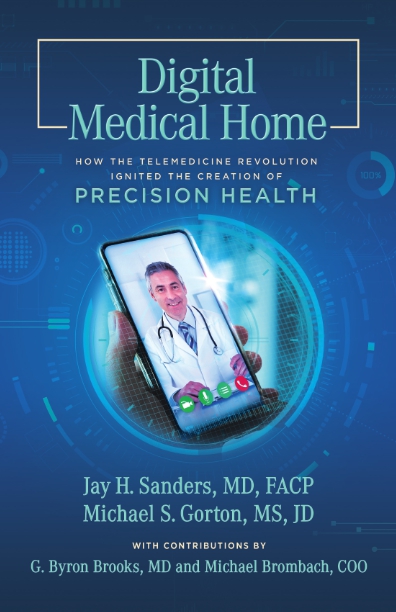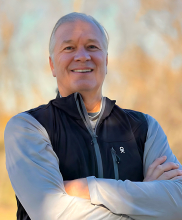
Prologue
When the great Spartan leader, Leonidas, faced an invading army, outnumbered a thousand to one, neither he nor his soldiers fled. Those Spartans lived by a creed whereby they understood the opposite of fear. In the early days of Teladoc, the DEA came into our office with guns and badges. Entrepreneurs must endure many challenges not seen in corporate America, but even the intrepid entrepreneur might cower when faced by circumstances like this. On that day, the 35 (or so) Teladoc employees did not run and hide. Like the Spartans, they knew the opposite of fear is love and passion. You will not run and hide if you believe in love, and are passionate about what is behind you, what you are defending. You stand strong and protect.
CHAPTER 1
The Traffic in Boston
Everything begins with an idea
— Earl Nightingale
In the Fall of 2002, Nelson woke up, excited about an important and busy day. He was overweight and not terribly healthy, so when he rolled out of bed, and felt something was different, he ignored it. Nelson had become an expert at ignoring health issues. Terry, his wife admonished him and told him to go to the doctor. That was not going to happen. Today’s important meeting would change the course of his business, and therefore could not be missed.
During the forty-five-minute drive from home to downtown Dallas, the problem worsened, but only a small amount. He thought it was probably a cold, or something he had eaten the night before. Nelson was always positive, tough, and determined. It was a determination that had painted the pathway of success in his life.
But then things suddenly changed. His vision began to blur, and the situation became catastrophic. Nelson lost control of his pickup truck at 75 miles per hour, and the fatality that occurred next was inevitable.
That scenario is a likely possibility, but it is not what happened on that day. Thirty-seven years earlier, on a hot day in Boston, the butterfly effect, the idea that small things that happened in the past can have non-linear impacts on a complex system, saved Nelson’s life.
Here is what really happened.
Nelson woke up, excited about and important and busy day. He was overweight and not terribly healthy, so when he rolled out of bed, and felt something was different, he ignored it. Nelson had become an expert at ignoring health issues. Terry, his wife admonished him and told him to go to the doctor. That was not going to happen. Today’s important meeting would change the course of his business, and therefore could not be missed.
As he was pulling out of the driveway that morning, he remembered he was a member of a new healthcare delivery system called Teladoc. He called in the service, and within minutes, Doctor Brooks was on his cell phone asking questions as he drove. As most people often do, Nelson ignored his beloved wife when she suggested he go to the doctor, but he took the advice of Dr. Brooks, who instructed him to drive directly to the ER.
Nelson took Dr. Brooks’ advice, and within a few minutes, he was in the local ER. A simple conversation with a physician who could listen, review an electronic medical record, and diagnose, saved Nelson’s life.
Dr. Brooks was the co-founder of Teladoc, a company he started because of a seed that pioneer, Jay Sanders, had planted a few years earlier during a speech at the University of Texas Medical Branch in Galveston. This book will tell the sometimes historic, other times startling tales of the road telemedicine took from 1967 Boston to where it is today. Telemedicine has created a new efficiency paradigm in care, and that engine is now on the precipice of an evolution that will revolutionize healthcare into the future. We will tell the complete story in the pages ahead.
First, the butterfly effect from the birth of telemedicine.
The Summer of Love (Jay H. Sanders, M.D.)
The summer of 1967 was explosive: riots, hippies, the Summer of Love, Vietnam, the Beatles, the Stones, and… the birth of telemedicine. Where was I? I was a senior medical resident at Massachusetts General Hospital (MGH) having just returned from two years of studying at the National Institute of Health. In those days, emergency medical specialties didn’t exist, and I was running the emergency department (ED). Back then, the senior medical resident and the surgical senior resident would each take two 12-hour shifts running the emergency department. Whoever was on the job, would see each patient that walked through that door and triage them. Every manner of case shows up in the emergency department (ED), so we definitely received intense training.
I remember vividly one particularly hot Boston summer day; I was working my 12-hour shift at the MGH ED, anticipating another traffic injury, chest pain, upper respiratory infection, broken bone, sprain, or abdominal pain. All of these are typical cases in the ED. Instead, the doors burst open and there stood Dr. Kenneth Bird, one of my professors of medicine. Though he was only about five foot seven, he was an imposing effigy. On this day, he was hot, sweaty, red-faced, and clearly upset. I had seen him this way enough times so that no one needed to explain this to me. I knew exactly why he was upset.
You see, the professors of medicine at the Massachusetts General Hospital in those days did not make much of an academic salary—probably no more than $8,000 a year. Many of them were moonlighting with their own private practices, and Dr. Bird was one of them. His second job was at Logan Airport where he was the medical director, treating airport employees and sick travelers. Dr. Bird had just come from Logan Airport and anyone who knows Boston knows that Logan Airport and the MGH are not far from each other—3.2 miles to be exact. For clarity, that is just over one mile of tortoise speeds up to and under the Sumner Tunnel, punctuated by over two miles of traffic lights and tourists darting on crowded streets crisscrossed by the historic Freedom Trail. In sum, the drive would burn an hour each way. The round trip was two exhausting hours spent in the car with no cell phone to create value or air conditioner to cool the frustration.
As might be expected, when brilliance is trapped in a place like the Sumner Tunnel with no air conditioning coupled with time management frustration, something great should be conceived. On this day, Dr. Bird burst through the doors of the MGH ED with an idea. We made eye contact, so he charged directly to me with purpose.
“Jay!” He began, grabbing my arm firmly.
I started to say something about how I was sorry he had gotten caught in traffic again, and I know it’s so frustrating, the traffic is terrible, yada yada…but he cut me off mid-sentence.
“No, that’s not it. I mean, yes, I did get caught in traffic. It is a senseless waste of time, but as I was parked in dead stop traffic under the Sumner and Charles River, I had this idea. What if I purchased two TV cameras and put one here in the ED and one at Logan Airport? I could examine patients over TV and avoid the traffic! What do you think?”
I searched his face for the glimmer of a smile, the whisper of laughter. Was he joking?! He was unsmiling, serious as could be. I thought it was the stupidest idea I had ever heard in my life, but what could I say? I was a resident, and he was my professor.
I had enough common sense to say simply, “Gee, Dr. Bird! That’s a very interesting idea.” If necessity is truly the mother of invention, then my professor’s necessity was moving with the ferocity of an avalanche.
Being the maverick that he was, Dr. Bird knew another maverick, Dr. John Knowles, who might be able to help him. Dr. Knowles was the general director of MGH. He was, in fact, willing and able to help, and he fed that avalanche by providing Ken with the money to buy those two TV cameras.
In June of 1968, about a year later, I was completing my third year of residency. I took a six-month hematology residency which began in July and was complete by December. Things were progressing with Ken Bird’s project and on January 1, 1969, I became the chief medical resident. More importantly, we had a fully functioning telemedicine system operating between the Mass General and Logan Airport Medical Station.
At Logan Airport Medical Station, there was a nurse who would communicate with the various faculty at the Mass General. From the MGH ED, the faculty would assess the patients at Logan Airport and the nurse would treat the patients as needed. What was most remarkable was that, in the late 1960s, most TV cameras were black and white! In addition, the NTSC standard at the time was 240 interlaced scanned lines simulating 480 lines of resolution. Compared with today’s TV and monitor resolution, it was TERRIBLE. Even with low resolution and no color, The Chair of Pathology, Dr. Benjamin Castleman and the Chair of Dermatology, Dr. Thomas Fitzpatrick used the system and got so good at interpreting the grayscale that they were basically able to determine the color of a lesion! At this time, my involvement with the telemedicine system was minimal, though I did get to run the first bone marrow sample out to Logan Airport to test if Dr. Castleman could read it from the MGH!
Of course, not everyone was in favor of this new and experimental way of practicing medicine. Dr. Thomas Dwyer, Head of the Department of Psychiatry, was more than skeptical. His words, as I remember them, were, “This system will never work for mental health patients! The special ambiance that exists between the psychiatrist and his or her patients in the room together can never be reproduced by a TV camera!”
Three years later, that same Dr. Dwyer and his faculty wrote a series of articles in the psychiatry literature demonstrating the incredible effectiveness of tele-psychiatry! It turned out that Dr. Dwyer discovered that not only could they reproduce that ambiance, but they could also manipulate it. Just like any movie director would tell you, you can create the emotions of the scene, not only by the dialogue, not only by the facial expressions, but also by how you shoot the scene. When the doctor wanted the patient to see that what they were telling them was important, they would lean in closer to the camera. When the patient didn’t seem ready to deal with the emotion of that moment, the doctor would minimize themself by leaning away from the camera. These were things that could not have been done as organically in the office, face-to-face.
The most important thing to note here is that one of telemedicine’s biggest naysayers ended up becoming one of its biggest proponents. The stupidest idea I had ever heard in my whole life was gaining traction.
And—spoiler alert—I have been working on that stupid idea ever since!



